Justice and Change in Global World Assignment 2022
VerifiedAdded on 2022/10/11
|5
|997
|20
Assignment
AI Summary
Contribute Materials
Your contribution can guide someone’s learning journey. Share your
documents today.
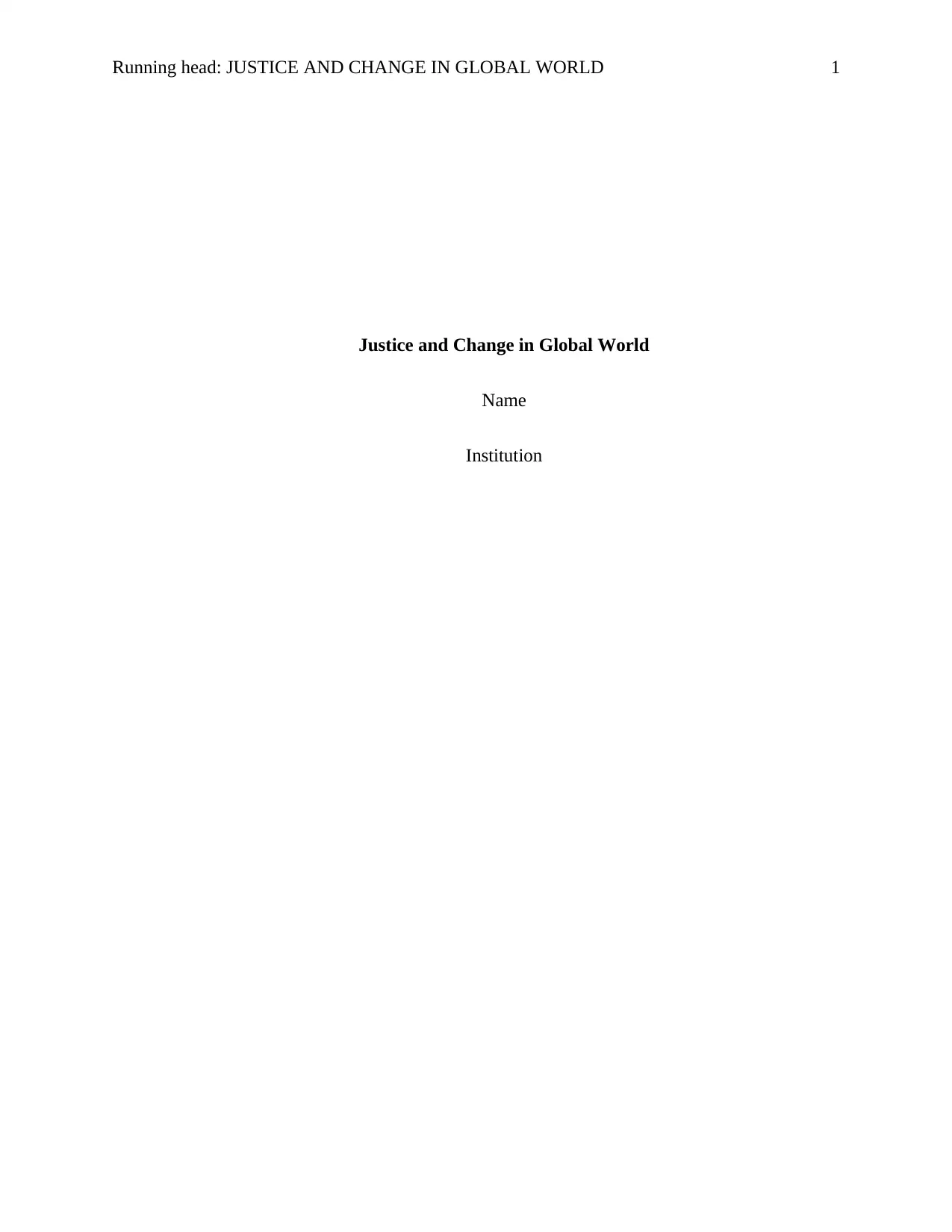
Running head: JUSTICE AND CHANGE IN GLOBAL WORLD 1
Justice and Change in Global World
Name
Institution
Justice and Change in Global World
Name
Institution
Secure Best Marks with AI Grader
Need help grading? Try our AI Grader for instant feedback on your assignments.
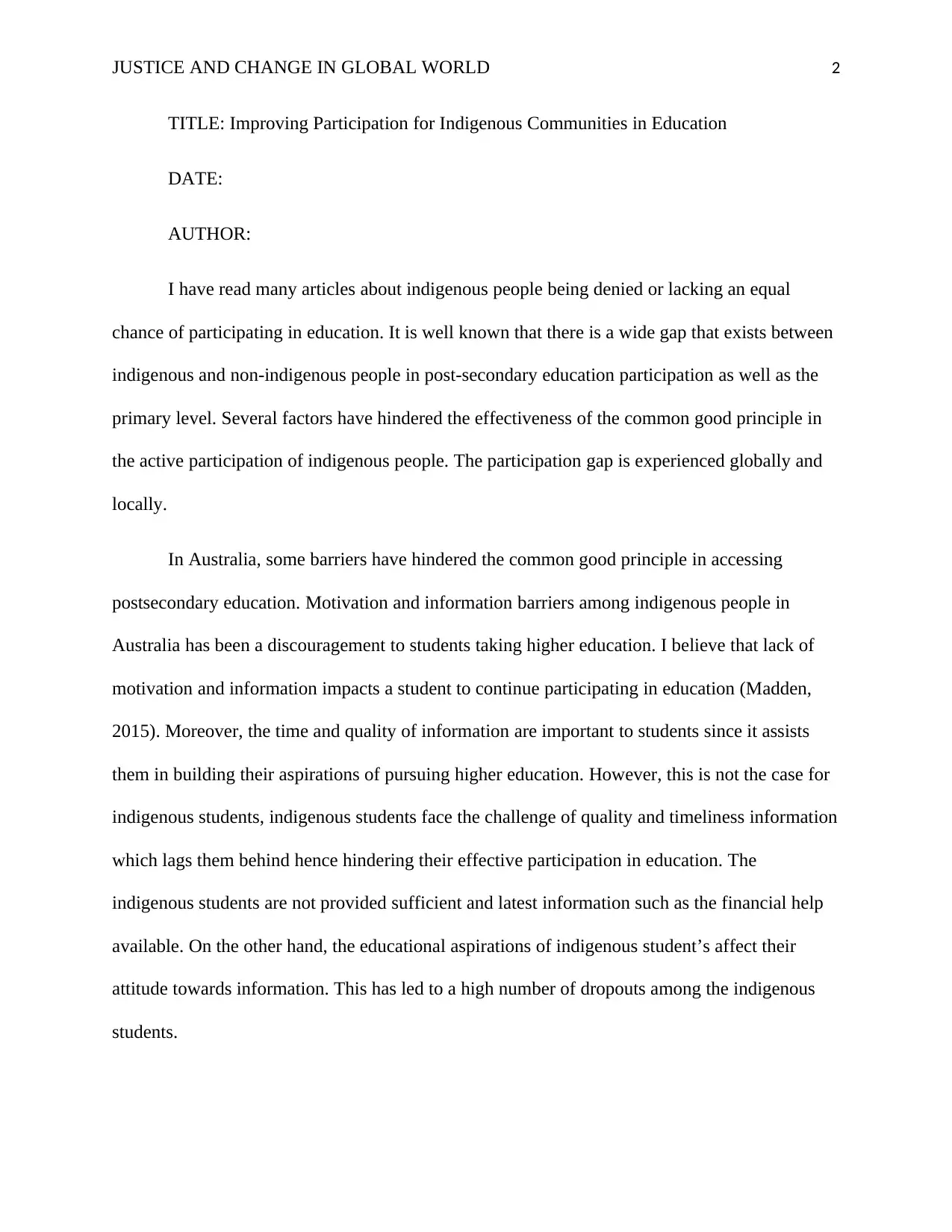
JUSTICE AND CHANGE IN GLOBAL WORLD 2
TITLE: Improving Participation for Indigenous Communities in Education
DATE:
AUTHOR:
I have read many articles about indigenous people being denied or lacking an equal
chance of participating in education. It is well known that there is a wide gap that exists between
indigenous and non-indigenous people in post-secondary education participation as well as the
primary level. Several factors have hindered the effectiveness of the common good principle in
the active participation of indigenous people. The participation gap is experienced globally and
locally.
In Australia, some barriers have hindered the common good principle in accessing
postsecondary education. Motivation and information barriers among indigenous people in
Australia has been a discouragement to students taking higher education. I believe that lack of
motivation and information impacts a student to continue participating in education (Madden,
2015). Moreover, the time and quality of information are important to students since it assists
them in building their aspirations of pursuing higher education. However, this is not the case for
indigenous students, indigenous students face the challenge of quality and timeliness information
which lags them behind hence hindering their effective participation in education. The
indigenous students are not provided sufficient and latest information such as the financial help
available. On the other hand, the educational aspirations of indigenous student’s affect their
attitude towards information. This has led to a high number of dropouts among the indigenous
students.
TITLE: Improving Participation for Indigenous Communities in Education
DATE:
AUTHOR:
I have read many articles about indigenous people being denied or lacking an equal
chance of participating in education. It is well known that there is a wide gap that exists between
indigenous and non-indigenous people in post-secondary education participation as well as the
primary level. Several factors have hindered the effectiveness of the common good principle in
the active participation of indigenous people. The participation gap is experienced globally and
locally.
In Australia, some barriers have hindered the common good principle in accessing
postsecondary education. Motivation and information barriers among indigenous people in
Australia has been a discouragement to students taking higher education. I believe that lack of
motivation and information impacts a student to continue participating in education (Madden,
2015). Moreover, the time and quality of information are important to students since it assists
them in building their aspirations of pursuing higher education. However, this is not the case for
indigenous students, indigenous students face the challenge of quality and timeliness information
which lags them behind hence hindering their effective participation in education. The
indigenous students are not provided sufficient and latest information such as the financial help
available. On the other hand, the educational aspirations of indigenous student’s affect their
attitude towards information. This has led to a high number of dropouts among the indigenous
students.
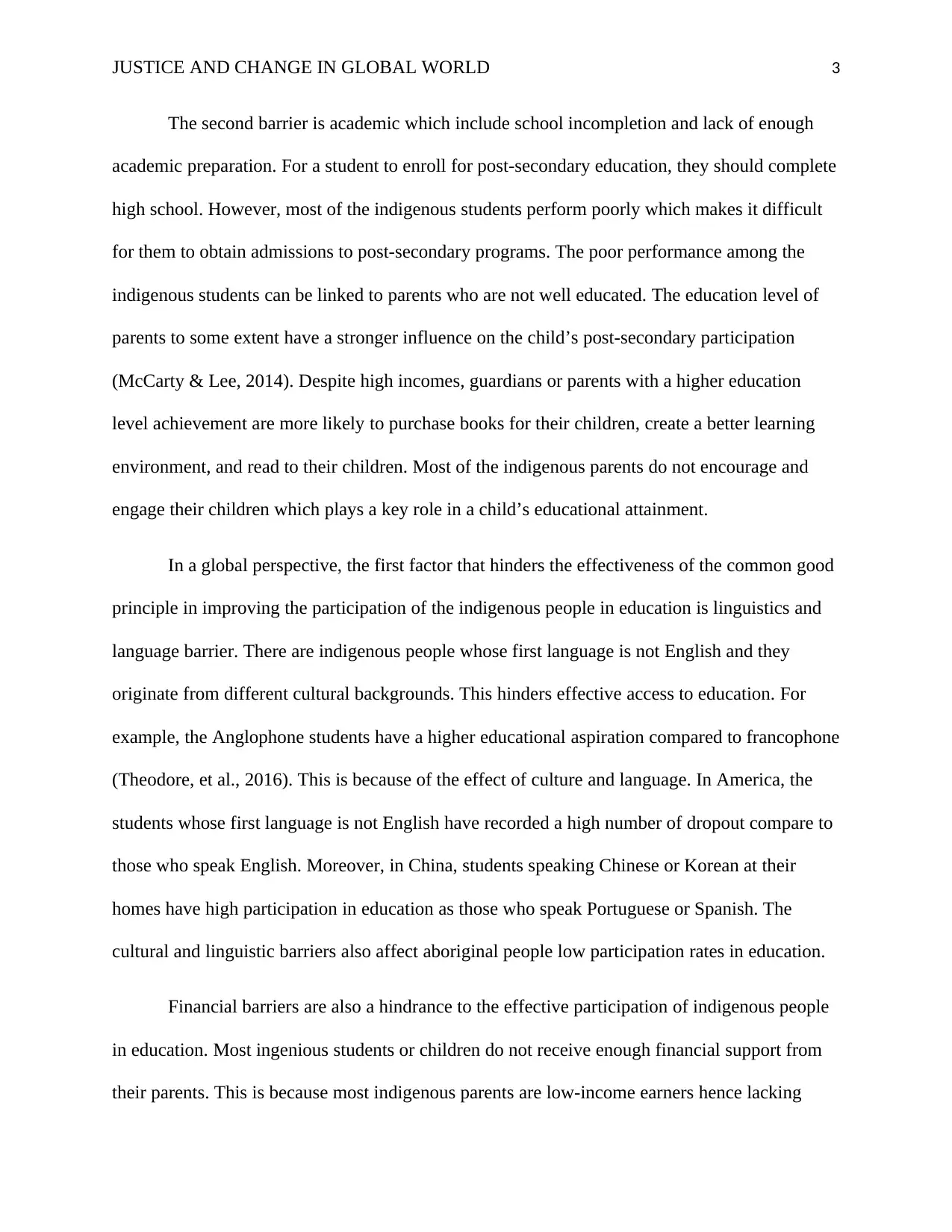
JUSTICE AND CHANGE IN GLOBAL WORLD 3
The second barrier is academic which include school incompletion and lack of enough
academic preparation. For a student to enroll for post-secondary education, they should complete
high school. However, most of the indigenous students perform poorly which makes it difficult
for them to obtain admissions to post-secondary programs. The poor performance among the
indigenous students can be linked to parents who are not well educated. The education level of
parents to some extent have a stronger influence on the child’s post-secondary participation
(McCarty & Lee, 2014). Despite high incomes, guardians or parents with a higher education
level achievement are more likely to purchase books for their children, create a better learning
environment, and read to their children. Most of the indigenous parents do not encourage and
engage their children which plays a key role in a child’s educational attainment.
In a global perspective, the first factor that hinders the effectiveness of the common good
principle in improving the participation of the indigenous people in education is linguistics and
language barrier. There are indigenous people whose first language is not English and they
originate from different cultural backgrounds. This hinders effective access to education. For
example, the Anglophone students have a higher educational aspiration compared to francophone
(Theodore, et al., 2016). This is because of the effect of culture and language. In America, the
students whose first language is not English have recorded a high number of dropout compare to
those who speak English. Moreover, in China, students speaking Chinese or Korean at their
homes have high participation in education as those who speak Portuguese or Spanish. The
cultural and linguistic barriers also affect aboriginal people low participation rates in education.
Financial barriers are also a hindrance to the effective participation of indigenous people
in education. Most ingenious students or children do not receive enough financial support from
their parents. This is because most indigenous parents are low-income earners hence lacking
The second barrier is academic which include school incompletion and lack of enough
academic preparation. For a student to enroll for post-secondary education, they should complete
high school. However, most of the indigenous students perform poorly which makes it difficult
for them to obtain admissions to post-secondary programs. The poor performance among the
indigenous students can be linked to parents who are not well educated. The education level of
parents to some extent have a stronger influence on the child’s post-secondary participation
(McCarty & Lee, 2014). Despite high incomes, guardians or parents with a higher education
level achievement are more likely to purchase books for their children, create a better learning
environment, and read to their children. Most of the indigenous parents do not encourage and
engage their children which plays a key role in a child’s educational attainment.
In a global perspective, the first factor that hinders the effectiveness of the common good
principle in improving the participation of the indigenous people in education is linguistics and
language barrier. There are indigenous people whose first language is not English and they
originate from different cultural backgrounds. This hinders effective access to education. For
example, the Anglophone students have a higher educational aspiration compared to francophone
(Theodore, et al., 2016). This is because of the effect of culture and language. In America, the
students whose first language is not English have recorded a high number of dropout compare to
those who speak English. Moreover, in China, students speaking Chinese or Korean at their
homes have high participation in education as those who speak Portuguese or Spanish. The
cultural and linguistic barriers also affect aboriginal people low participation rates in education.
Financial barriers are also a hindrance to the effective participation of indigenous people
in education. Most ingenious students or children do not receive enough financial support from
their parents. This is because most indigenous parents are low-income earners hence lacking
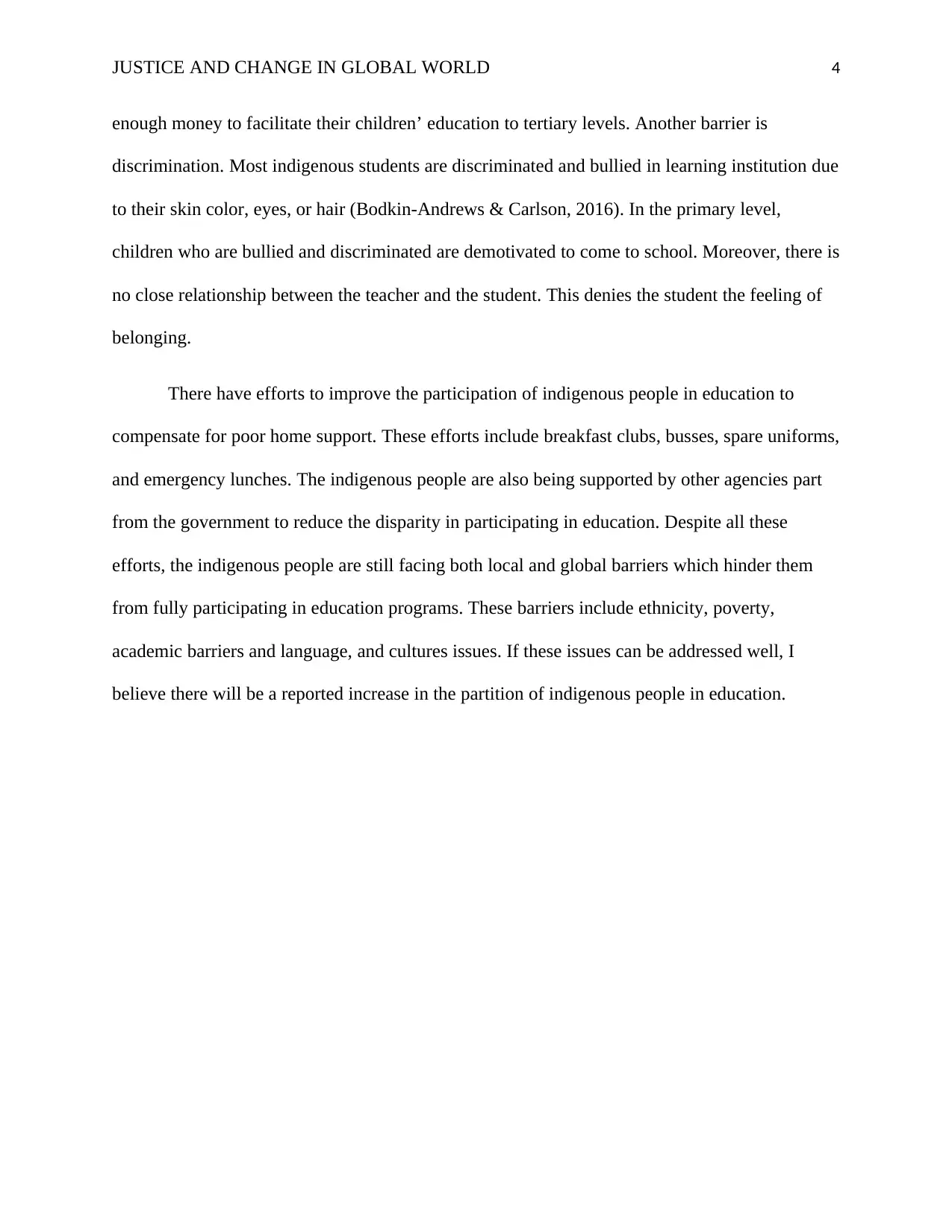
JUSTICE AND CHANGE IN GLOBAL WORLD 4
enough money to facilitate their children’ education to tertiary levels. Another barrier is
discrimination. Most indigenous students are discriminated and bullied in learning institution due
to their skin color, eyes, or hair (Bodkin-Andrews & Carlson, 2016). In the primary level,
children who are bullied and discriminated are demotivated to come to school. Moreover, there is
no close relationship between the teacher and the student. This denies the student the feeling of
belonging.
There have efforts to improve the participation of indigenous people in education to
compensate for poor home support. These efforts include breakfast clubs, busses, spare uniforms,
and emergency lunches. The indigenous people are also being supported by other agencies part
from the government to reduce the disparity in participating in education. Despite all these
efforts, the indigenous people are still facing both local and global barriers which hinder them
from fully participating in education programs. These barriers include ethnicity, poverty,
academic barriers and language, and cultures issues. If these issues can be addressed well, I
believe there will be a reported increase in the partition of indigenous people in education.
enough money to facilitate their children’ education to tertiary levels. Another barrier is
discrimination. Most indigenous students are discriminated and bullied in learning institution due
to their skin color, eyes, or hair (Bodkin-Andrews & Carlson, 2016). In the primary level,
children who are bullied and discriminated are demotivated to come to school. Moreover, there is
no close relationship between the teacher and the student. This denies the student the feeling of
belonging.
There have efforts to improve the participation of indigenous people in education to
compensate for poor home support. These efforts include breakfast clubs, busses, spare uniforms,
and emergency lunches. The indigenous people are also being supported by other agencies part
from the government to reduce the disparity in participating in education. Despite all these
efforts, the indigenous people are still facing both local and global barriers which hinder them
from fully participating in education programs. These barriers include ethnicity, poverty,
academic barriers and language, and cultures issues. If these issues can be addressed well, I
believe there will be a reported increase in the partition of indigenous people in education.
Secure Best Marks with AI Grader
Need help grading? Try our AI Grader for instant feedback on your assignments.
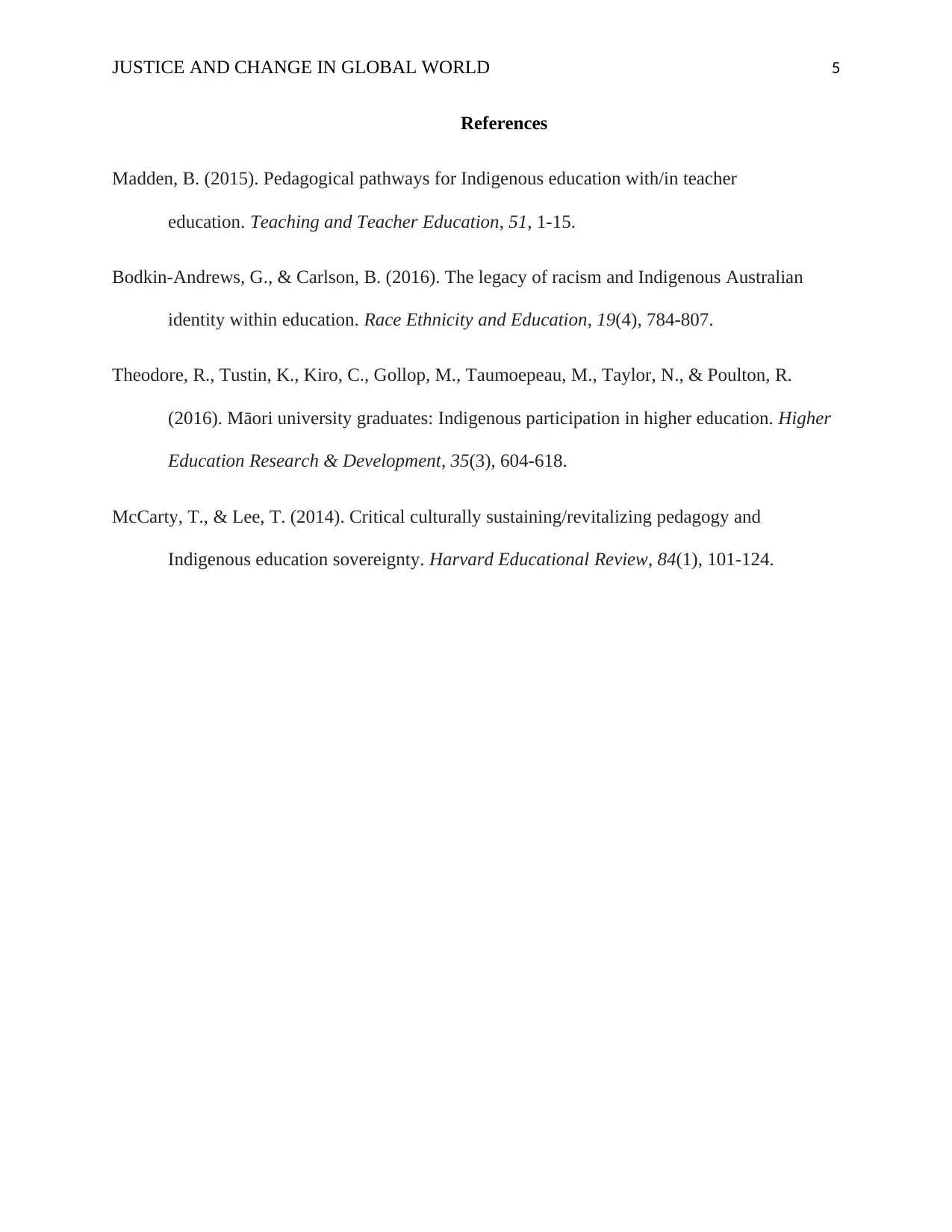
JUSTICE AND CHANGE IN GLOBAL WORLD 5
References
Madden, B. (2015). Pedagogical pathways for Indigenous education with/in teacher
education. Teaching and Teacher Education, 51, 1-15.
Bodkin-Andrews, G., & Carlson, B. (2016). The legacy of racism and Indigenous Australian
identity within education. Race Ethnicity and Education, 19(4), 784-807.
Theodore, R., Tustin, K., Kiro, C., Gollop, M., Taumoepeau, M., Taylor, N., & Poulton, R.
(2016). Māori university graduates: Indigenous participation in higher education. Higher
Education Research & Development, 35(3), 604-618.
McCarty, T., & Lee, T. (2014). Critical culturally sustaining/revitalizing pedagogy and
Indigenous education sovereignty. Harvard Educational Review, 84(1), 101-124.
References
Madden, B. (2015). Pedagogical pathways for Indigenous education with/in teacher
education. Teaching and Teacher Education, 51, 1-15.
Bodkin-Andrews, G., & Carlson, B. (2016). The legacy of racism and Indigenous Australian
identity within education. Race Ethnicity and Education, 19(4), 784-807.
Theodore, R., Tustin, K., Kiro, C., Gollop, M., Taumoepeau, M., Taylor, N., & Poulton, R.
(2016). Māori university graduates: Indigenous participation in higher education. Higher
Education Research & Development, 35(3), 604-618.
McCarty, T., & Lee, T. (2014). Critical culturally sustaining/revitalizing pedagogy and
Indigenous education sovereignty. Harvard Educational Review, 84(1), 101-124.
1 out of 5
Related Documents
Your All-in-One AI-Powered Toolkit for Academic Success.
+13062052269
info@desklib.com
Available 24*7 on WhatsApp / Email
![[object Object]](/_next/static/media/star-bottom.7253800d.svg)
Unlock your academic potential
© 2024 | Zucol Services PVT LTD | All rights reserved.





